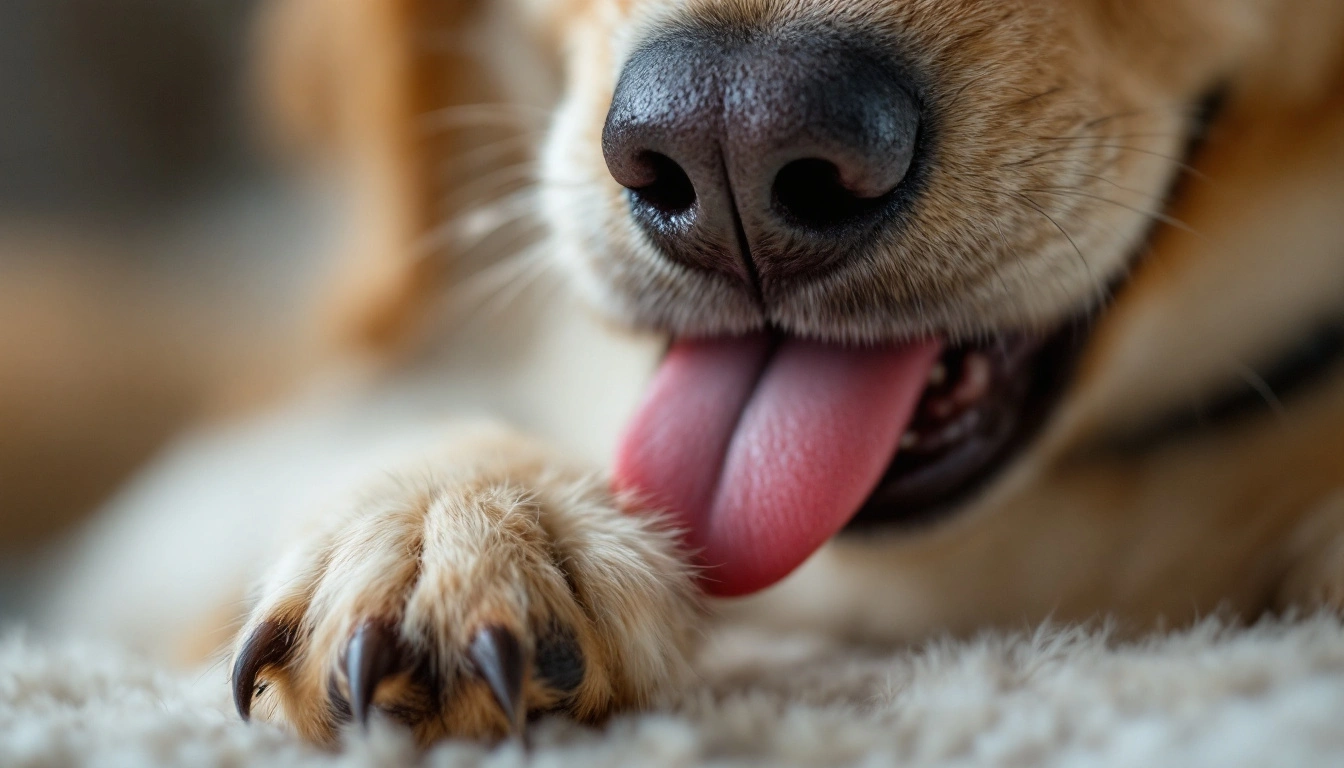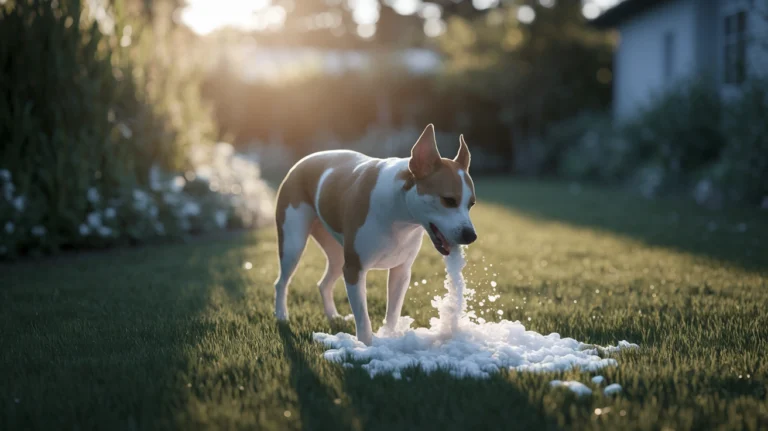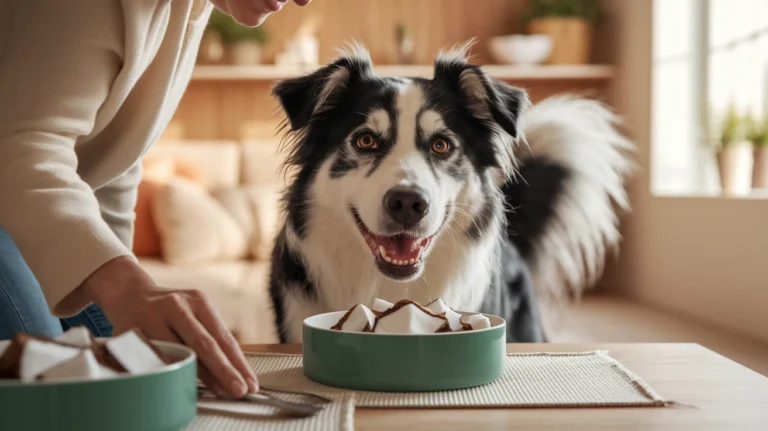Why do dogs lick their paws? Discover 5 common causes from allergies to anxiety, plus practical solutions to help your furry friend find relief from excessive paw licking.
If you’ve ever caught your furry friend obsessively licking their paws, you might have wondered: why do dogs lick their paws so much? While occasional paw licking is perfectly normal canine behavior—part of their natural grooming routine—excessive paw licking can signal underlying issues that deserve attention. As responsible pet owners, understanding the difference between normal grooming and problematic licking can help ensure our canine companions remain healthy and comfortable. In this comprehensive guide, we’ll explore the five most common reasons why dogs lick their paws, when this behavior warrants veterinary attention, and practical solutions to address excessive paw licking.
Table of Contents
Normal Grooming Behavior
Dogs are naturally clean animals, and paw licking is an integral part of their self-maintenance routine. In the wild, canines lick their paws to remove dirt, debris, and foreign substances they may have stepped on during their daily activities. This instinctual behavior has carried through to our domesticated pets.
How Dogs Naturally Clean Themselves
When dogs lick their paws as part of normal grooming:
- They typically spend a few minutes on each paw
- The behavior occurs after walks or outdoor activities
- Licking is performed methodically and purposefully
- The dog appears relaxed during the grooming session
According to a 2023 study by the American Veterinary Association, healthy dogs spend approximately 2-5% of their waking hours engaged in self-grooming behaviors, including paw licking. This translates to roughly 15-30 minutes spread throughout the day for an average adult dog.
Distinguishing Normal from Excessive
Normal paw licking is:
- Brief and occasional
- Not accompanied by signs of distress
- Doesn’t result in skin discoloration or hair loss
- Doesn’t wake the dog from sleep to perform
When paw licking transitions from normal grooming to excessive behavior, it often indicates that something more serious may be affecting your pet’s health or emotional well-being.
Allergies and Skin Irritation
Perhaps the most common medical reason why dogs lick their paws excessively is allergies. Just like humans, dogs can develop allergic reactions to various environmental factors, food ingredients, or substances they come into contact with.
Environmental Allergies
Environmental allergies (atopic dermatitis) affect approximately 10-15% of the canine population, according to the Cornell University College of Veterinary Medicine. Common environmental allergens include:
- Pollen from trees, grasses, and weeds
- Mold spores
- Dust mites
- Cleaning products and household chemicals
When dogs walk through allergen-laden areas, these substances can stick to their paws and cause irritation. The natural response is to lick the affected area for relief, often leading to a cycle of inflammation and increased licking.
Food Allergies
Food allergies or sensitivities can manifest as skin problems, including itchy paws. Research from the Journal of Veterinary Dermatology suggests that approximately 10% of all canine allergies are food-related. The most common food allergens for dogs include:
- Beef
- Dairy products
- Chicken
- Wheat
- Soy
- Eggs
- Lamb
Food allergies typically develop over time, even to proteins your dog has eaten without issue for years. Unlike environmental allergies that may be seasonal, food allergies tend to cause year-round symptoms.
Contact Allergies
Dogs can also develop contact dermatitis from touching irritating substances, including:
- De-icing salts and chemicals used on roads and sidewalks
- Fertilizers and pesticides on lawns
- Certain cleaning products used on floors
- Some types of carpet fibers or floor treatments
Symptoms of Allergic Reactions in Paws
When allergies are causing your dog to lick their paws, you might notice:
- Redness between the toes and paw pads
- Swelling of the paws
- Brown or reddish discoloration of the fur (caused by the dog’s saliva)
- Inflamed skin
- Secondary yeast or bacterial infections from constant moisture
Recent statistics indicate that paw allergies account for approximately 30-40% of all cases where dogs excessively lick their paws, making it the leading cause of this behavior.
Pain and Discomfort
Dogs often lick areas of their body that are experiencing pain or discomfort as a natural soothing mechanism. When it comes to paw licking, several painful conditions could be the underlying cause.
Foreign Objects
Dogs frequently step on sharp or irritating objects that can become lodged in their paw pads or between their toes, such as:
- Thorns, splinters, or plant awns
- Small pieces of glass or metal
- Rocks or pebbles
- Ice balls during winter months
According to emergency veterinary statistics, foreign body removal from paws accounts for approximately 7% of emergency vet visits related to paw issues.
Injuries and Trauma
Physical injuries to the paw can trigger licking behavior, including:
- Cuts or puncture wounds
- Broken or torn nails
- Bruises from impact on hard surfaces
- Burns from hot pavement (which can reach 125°F when air temperature is just 77°F)
- Frostbite in cold weather conditions
Arthritis and Joint Pain
Many dogs, especially seniors, suffer from arthritis or other joint conditions that can cause pain in their paws and limbs. Research from the Arthritis Foundation for Animals suggests that approximately 20% of dogs over the age of 7 show signs of arthritis, with the percentage increasing to over 65% in dogs older than 12 years.
When arthritis affects the joints in a dog’s paws or wrists, they often lick the area in an attempt to relieve the discomfort. This licking may temporarily increase blood flow to the region and provide momentary relief.
How to Identify Pain-Related Licking
Pain-induced paw licking typically shows these characteristics:
- Focused on one particular paw rather than all four
- Accompanied by limping or favoring the affected limb
- The dog may be reluctant to put weight on the paw
- Signs of discomfort when the area is touched
- Potential swelling, heat, or visible injury
Studies show that approximately 15-25% of excessive paw licking cases are directly related to pain or physical discomfort.
Boredom and Anxiety
Mental and emotional factors can significantly contribute to why dogs lick their paws excessively. Just as humans might bite their nails when anxious, dogs often develop repetitive behaviors like paw licking as a coping mechanism.
Psychological Factors Behind Excessive Licking
Veterinary behaviorists estimate that approximately 20-22% of excessive paw licking cases stem from psychological rather than physical causes. These include:
Anxiety and Stress
Common anxiety triggers that may lead to paw licking include:
- Separation from owners
- Changes in the household (new pets, babies, moving)
- Thunderstorms or fireworks
- Travel or unfamiliar environments
- Conflict with other pets
A 2022 study published in the Journal of Veterinary Behavior found that dogs with diagnosed anxiety disorders were 3.5 times more likely to exhibit excessive licking behaviors than those without anxiety.
Boredom and Understimulation
Dogs are intelligent animals that need mental and physical stimulation. When understimulated:
- High-energy breeds are particularly susceptible to developing repetitive behaviors
- Dogs left alone for extended periods may resort to paw licking as a self-soothing activity
- The behavior often intensifies during periods of inactivity
Compulsive Disorders
In some cases, what begins as stress-related licking can develop into a compulsive disorder. Canine compulsive disorders affect approximately 3-4% of the domestic dog population and are more common in certain breeds like Doberman Pinschers, German Shepherds, and Labrador Retrievers.
Signs that paw licking has become compulsive include:
- The dog seems “zoned out” while licking
- Licking continues despite distractions
- The behavior interrupts normal activities like eating or sleeping
- Physical damage to the paw develops but doesn’t deter the licking
Breed Predispositions
Some breeds are genetically predisposed to obsessive-compulsive behaviors, including excessive licking:
| Breed | Risk Factor for Compulsive Licking |
| Doberman Pinscher | High |
| German Shepherd | High |
| Labrador Retriever | Moderate to High |
| Golden Retriever | Moderate |
| Border Collie | Moderate |
| Dalmatian | Moderate |
| Poodle | Low to Moderate |
Parasites and Infections
Microscopic invaders can cause significant discomfort to your dog’s paws, triggering licking as a response to irritation.
Common Parasites Affecting Dog Paws
Demodectic Mange
Caused by Demodex mites that naturally live in dog hair follicles, demodectic mange occurs when these mites multiply excessively. Puppies and dogs with compromised immune systems are particularly vulnerable. According to veterinary dermatology statistics:
- Approximately 5% of young dogs develop localized demodectic mange
- Of these cases, 10-15% involve the paws
- The condition creates intense itching that triggers licking behavior
Sarcoptic Mange (Scabies)
Highly contagious and intensely itchy, sarcoptic mange is caused by the Sarcoptes scabiei mite. These parasites:
- Burrow into the skin, causing extreme discomfort
- Often target areas with less hair, including paw margins
- Can spread between dogs and temporarily to humans
- Affect approximately 3-8% of dogs with skin disorders
Fleas and Ticks
While these parasites are often associated with other body areas, they can also infest paws, especially:
- Between toes
- Around nail beds
- Under paw pads in severe infestations
Bacterial and Fungal Infections
Bacterial Infections
When dogs lick their paws excessively due to another underlying issue, the constant moisture creates an ideal environment for bacteria to flourish. Common bacterial infections include:
- Pyoderma (bacterial skin infection)
- Interdigital furunculosis (painful bacterial infection between toes)
- Pododermatitis (inflammation of the paw skin)
Research indicates that secondary bacterial infections are present in approximately 25-30% of cases where dogs lick their paws excessively, often complicating the original problem.
Yeast Infections
Malassezia dermatitis, a yeast infection commonly affecting dog paws, creates:
- A distinctive musty, yeasty odor
- Reddish-brown discoloration
- Greasy, sometimes crusty skin
- Intense itchiness that prompts licking
A 2021 study published in Veterinary Dermatology found that Malassezia yeast infections were present in approximately 30-40% of dogs with chronic paw licking habits.
Ringworm
Despite its name, ringworm is a fungal infection, not a parasitic worm. When it affects the paws:
- It creates circular, scaly patches
- Hair loss occurs in the affected area
- The infection is highly contagious to other pets and humans
Approximately 2% of canine dermatological cases involve ringworm infections.
When to See a Veterinarian
While some paw licking is normal, knowing when to consult a professional is crucial for your dog’s wellbeing.
Warning Signs That Require Veterinary Attention
Contact your veterinarian if you notice:
- Excessive frequency – Licking that becomes obsessive or prevents normal activities
- Physical changes – Redness, swelling, discharge, or unpleasant odor
- Behavioral changes – Limping, reluctance to walk, or signs of pain
- Visible damage – Hair loss, raw skin, or open sores on the paws
- Spreading symptoms – Licking that extends to multiple paws or other body parts
A survey of veterinary practices revealed that approximately 60% of cases where dogs lick their paws excessively have an underlying medical cause that requires treatment.
Diagnostic Process
When you bring your dog to the veterinarian for excessive paw licking, they may perform:
- Physical examination – Detailed inspection of all paws and assessment of gait
- Skin scraping or cytology – To check for parasites and infection
- Allergy testing – Blood tests or intradermal skin tests to identify allergens
- Food elimination trials – To identify potential food allergies
- X-rays or advanced imaging – If physical injury or arthritis is suspected
- Behavioral assessment – To evaluate psychological factors
Early intervention significantly improves outcomes, with studies showing that treatment success rates drop by approximately 15% for every month that excessive paw licking continues without proper veterinary care.
Solutions for Excessive Paw Licking
Addressing why dogs lick their paws requires targeting the underlying cause. Here are effective solutions based on the specific triggers:
Managing Allergies
Environmental Allergy Management
- Regular paw washing – Rinse your dog’s paws with warm water after walks to remove allergens
- Hypoallergenic wipes – Use specially formulated pet wipes for quick cleaning
- Protective booties – Consider dog boots for walks during high pollen seasons
- HEPA filters – Install home air purifiers to reduce airborne allergens
- Medicated solutions – Ask your veterinarian about antihistamines or specialized medications
Food Allergy Solutions
- Elimination diet – Remove potential allergens from your dog’s diet under veterinary supervision
- Hydrolyzed protein diets – These specially processed foods break down proteins into pieces too small to trigger allergic reactions
- Limited ingredient diets – Foods with minimal ingredients help identify and avoid allergens
Research shows that approximately 70% of dogs with food allergies show significant improvement within 8-12 weeks on an appropriate elimination diet.
Addressing Pain and Injuries
- First aid for minor wounds – Clean cuts with veterinary-approved antiseptic solutions
- Foreign object removal – Carefully extract visible splinters or debris
- Anti-inflammatory medications – Veterinarian-prescribed NSAIDs for pain and inflammation
- Joint supplements – Glucosamine and chondroitin for dogs with arthritis
- Protective gear – Boots or paw wax to prevent burns and chemical exposure
Treating Infections and Parasites
- Antifungal medications – Prescription treatments for yeast and fungal infections
- Antibiotics – For bacterial infections, typically requiring 2-4 weeks of treatment
- Antiparasitic treatments – Oral medications or topical solutions for mite infestations
- Environmental treatment – Cleaning bedding and living areas to prevent reinfestation
A 2023 study from the American Veterinary Medical Association found that approximately 85% of parasitic and infectious causes of paw licking resolve completely with appropriate treatment.
Behavioral Solutions
For Anxiety and Stress
- Behavior modification – Desensitization and counterconditioning techniques
- Anxiety wraps – Pressure wraps like Thundershirts that provide calming reassurance
- Pheromone products – Adaptil diffusers or sprays that mimic calming dog pheromones
- Prescription anti-anxiety medications – For severe cases, veterinarian-prescribed treatments
For Boredom
- Increased exercise – Most dogs need at least 30-60 minutes of physical activity daily
- Mental stimulation – Puzzle toys, training sessions, and nose work activities
- Interactive play – Games that require focus and engagement
- Enrichment activities – Rotating toys and introducing new experiences
Veterinary behaviorists report that approximately 65% of boredom-related paw licking cases show significant improvement with proper environmental enrichment and exercise regimens.
Physical Deterrents
When necessary to prevent self-injury while addressing underlying causes:
- Bitter apple spray – Safe, bad-tasting deterrents applied to paws
- Medical boots or socks – Protective coverings that prevent direct licking
- Elizabethan collars (E-collars) – Prevent access to paws in severe cases
- Inflatable collars – More comfortable alternative to traditional E-collars
Recommended Pet Products
Title: Recommended Pet Products on Amazon
Based on research and veterinary recommendations, these products may help address why dogs lick their paws:
- Zymox Enzymatic Topical Cream – Contains patented enzymes that help treat bacterial, fungal, and yeast infections without antibiotics
- Douxo S3 PYO Antiseptic Paw Pads – Medicated wipes specifically formulated for cleaning between dog toes and removing allergens
- ThunderEase Dog Calming Diffuser Kit – Releases calming pheromones that help reduce anxiety-related behaviors, including excessive licking
- Outward Hound Nina Ottosson Dog Puzzle Toy – Provides mental stimulation and helps prevent boredom-induced licking behaviors
Frequently Asked Questions
Is it normal for dogs to lick their paws?
Yes, occasional paw licking is normal grooming behavior for dogs. Most healthy dogs will spend a few minutes each day licking their paws to clean them, especially after being outside. However, when licking becomes excessive—defined as more than a few minutes at a time or multiple times per day—it often indicates an underlying issue that needs attention.
How much paw licking is too much?
Excessive licking typically means:
- Licking that continues for more than a few minutes at a time
- Licking that causes hair loss, redness, or irritation
- Licking that wakes your dog from sleep
- Licking that your dog cannot be easily distracted from
- Licking that occurs multiple times per day
Veterinary behaviorists suggest that any licking session lasting more than 5 consecutive minutes or occurring more than 3-4 times daily warrants monitoring and potential investigation.
Can seasonal allergies cause dogs to lick their paws?
Absolutely. Seasonal allergies are among the most common reasons why dogs lick their paws excessively. Allergens like pollen, mold spores, and grass can stick to paw pads and between toes, causing irritation. Studies show that approximately 60% of dogs with atopic dermatitis (environmental allergies) exhibit paw licking as a primary symptom.
The seasonal pattern of your dog’s licking can provide valuable clues:
- Spring/Summer: Often related to pollen and grass allergies
- Fall: Frequently associated with ragweed and mold allergies
- Winter: More commonly linked to indoor allergens like dust mites
Do certain breeds lick their paws more than others?
Yes, breed predispositions exist. Breeds with a higher tendency toward allergies and subsequent paw licking include:
- West Highland White Terriers
- Bulldogs (English and French)
- Labrador Retrievers
- Golden Retrievers
- Boxers
- German Shepherds
- Pugs
Additionally, breeds prone to compulsive behaviors (like those mentioned in the Boredom and Anxiety section) may develop excessive licking habits more readily.
Can my dog’s diet affect paw licking behavior?
Yes, diet plays a significant role. Food allergies or sensitivities can manifest as itchy paws, prompting licking. Additionally, nutritional imbalances may contribute to skin problems that cause discomfort.
A 2023 study in the Journal of Veterinary Nutrition found that approximately 20% of dogs with chronic paw licking showed improvement after switching to a high-quality, balanced diet with adequate omega-3 fatty acids.
How can I tell if my dog is licking due to pain or allergies?
Key differences to observe:
Pain-related licking:
- Usually focused on one particular paw
- Often accompanied by limping or favoring the paw
- The dog may react when the specific area is touched
- Licking may be intense but limited to the painful area
Allergy-related licking:
- Typically affects multiple paws
- Often accompanied by licking or chewing other itchy areas
- May be seasonal or year-round depending on the allergen
- The dog may also show other allergy symptoms like ear infections or sneezing
Can anxiety medication help a dog that licks their paws obsessively?
Yes, in certain cases. When behavioral assessments confirm that anxiety is the primary cause of paw licking, anti-anxiety medications may be prescribed by veterinarians as part of a comprehensive treatment plan. These medications typically work best when combined with behavior modification techniques and environmental management.
Studies show that approximately 70-75% of dogs with anxiety-induced licking behaviors show improvement with appropriate medication and behavior modification. However, medication alone rarely resolves the issue completely.
What home remedies are safe for soothing irritated paws?
Safe home remedies include:
- Epsom salt soaks – Dissolve 1/2 cup in a gallon of warm water and soak paws for 5-10 minutes
- Coconut oil – Apply a thin layer of organic, unrefined coconut oil to moisturize dry pads
- Oatmeal baths – Colloidal oatmeal added to warm water can soothe irritated skin
- Cold compresses – For inflamed, hot spots on paws
Always consult with your veterinarian before trying home remedies, especially if your dog has open wounds or if the condition appears severe.
Call-to-Action
Is your furry friend showing signs of excessive paw licking? Understanding why dogs lick their paws is just the beginning of proper pet care. For more expert recommendations and in-depth pet care guides, explore BlithePet , where you’ll find comprehensive resources on pet health, behavior, and wellness.
Conclusion Why Do Dogs Lick Their Paws
Understanding why dogs lick their paws is crucial for maintaining your pet’s health and comfort. While occasional paw licking is a normal part of canine grooming behavior, excessive licking typically signals an underlying issue that requires attention. From allergies and pain to anxiety and infections, the causes are diverse and sometimes complex.
By identifying the specific reason for your dog’s paw licking, you can implement targeted solutions to address the root cause rather than just trying to stop the behavior. Remember that early intervention typically leads to faster resolution and prevents the development of secondary problems like skin damage or compulsive behaviors.
If your dog’s paw licking seems excessive or is accompanied by other concerning symptoms, don’t hesitate to consult with your veterinarian. With proper diagnosis and treatment, most dogs can find relief from the discomfort that drives them to lick excessively.
Have you discovered an effective solution for your dog’s paw licking? Share your experience in the comments below and help other pet parents navigate this common canine concern.







